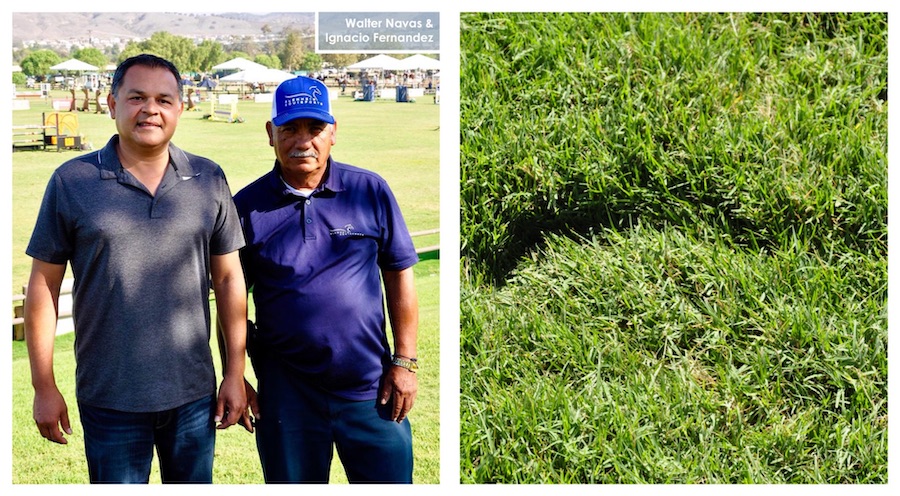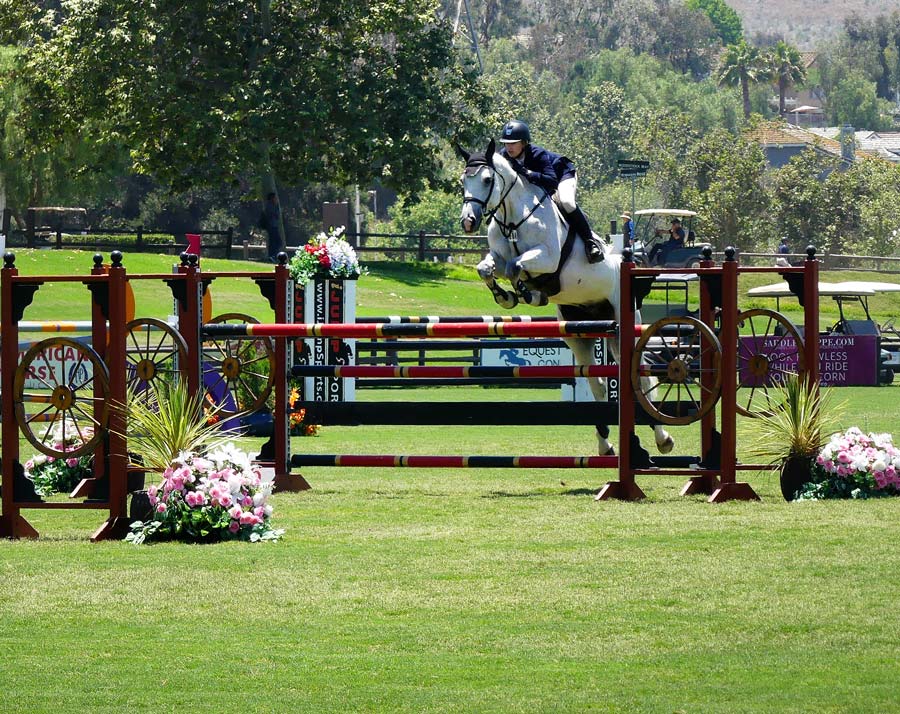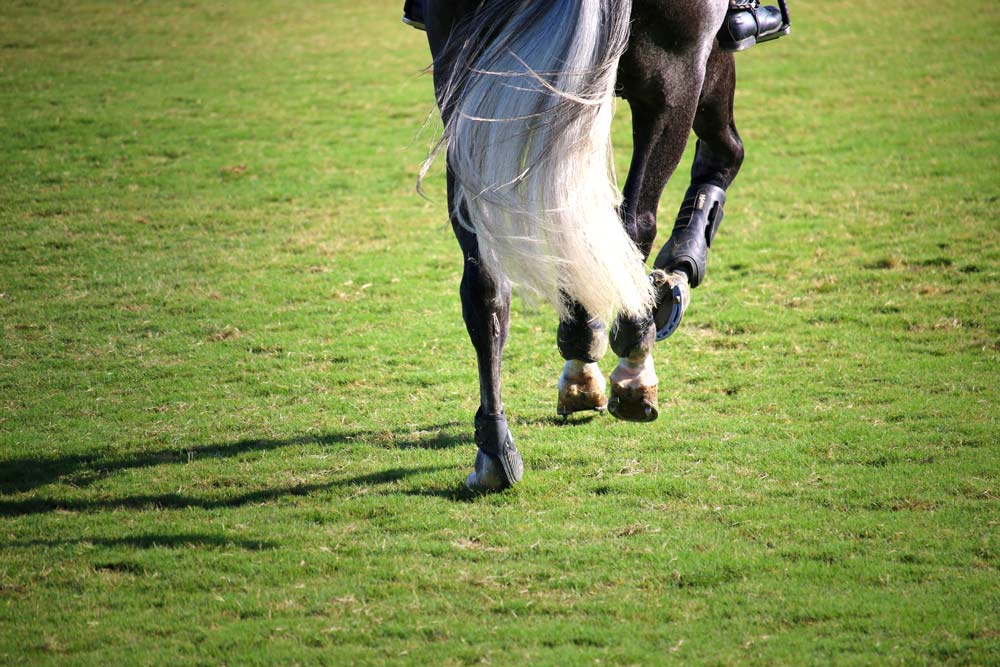by Meghan Covert & Jackie McFarland
One of the first things to catch your eye when arriving at the Rancho Viejo Riding Park at San Juan Capistrano are the gorgeous grass fields glistening in the sun. The beauty of the park gives visitors the chance to enjoy the outdoors, while watching amazing animals jump big obstacles. Horse show competitors relish the opportunity to ride on these fields, drawn by the allure of the emerald green space.
Of the hundreds of horse shows produced annually, only a handful offer the chance to experience the glory of galloping on grass. The fields at the Rancho Mission Viejo Riding Park at San Juan Capistrano may appear to be a typical expanse of grass to most, but unlike a soccer field or a golf course, these show jumping fields must be able to withstand the effects of hundreds of performance horses, weighing upwards of 1,200 pounds, wearing metal shoes with studs, who are running and jumping on it for multiple days in a row for three seasons each year. In order to keep the horses and their riders safe and sound, Blenheim EquiSports has a deeply rooted strategic plan to keep the grass in good standing.
The Green Thumbs of Blenheim Facility Management
Walter “Walt” Navas and Ignacio “Nacho” Fernandez, the duo who manage the grass, are the green thumbs that are constantly watching and working on the prized fields. All the details of grass growth and management are in the hands of these two men who work tirelessly to make this blanket of green the best it can be.

Navas, who started this pursuit in 2000, is responsible for the “master plan” of the facility. Fernandez handles more of the hands-on work. Both are aware of everything that is happening with the grass, know what needs to be done, and together, they create the formulas that keep the fields healthy and safe for horses and riders.
Along with being Vice President of Marketing, Melissa Brandes plays a role in Blenheim Facility Management. She notes how Navas and Fernandez work. “Walt and Nacho confer everyday and make a plan. So when they water it, they don’t make decisions about the field as a whole. They evaluate the field in pieces. There’s such a science to everything they do – the weather, the use, what the grass is doing, how its appearing, how its holding up to the horses riding on it. and they make a watering and treatment plan accordingly.”
Aeration is Essential
One aspect that sets these fields apart is its composition, a hybrid of Santa Ana and Bermuda grass. This combination provides great lateral growth and is hearty enough to tolerate the all-day-long pounding of the equine traffic. After growing this ideal mix, the most important factor in determining the quality of the field for show jumping sport is aeration.
What is aeration? The process by which air is circulated through the grass, via punching it with a machine or hand-tool. With the formula that Navas and Fernandez have developed over the years, the grass stays healthy, creating a cushion for the horses to land on.
“Aeration is what oxygenates the field. But it’s far from simple to do it right. You have to have that perfect formula where you’re giving it enough breathability to stay healthy, induce new growth, and give it that springy feeling,” Brandes says.
Navas indicates that green grass is only as good as what is underneath. “The truth of the matter is the turf of the field isn’t really what makes the field good. What makes the field good is having these holes about two and a half inches apart. What happens is once the horses land, they loosen the top layer, but you don’t lose the holes underneath. Then when you put water down, the water goes to the bottom and the roots are chasing the water so it makes the roots really strong because they’re constantly chasing that water underneath the surface.”
Preparation and Protection
Due to the horse shows running from Spring into Fall, the growing process begins in late November and continues through January. Because grass is usually dormant during this period, Navas has developed several strategies, like topdressing and feeding special nutrients, to encourage the grass to grow through the winter. The off-season care, management and maintenance that Navas and Fernandez give the fields determine the quality of the field for the rest of the show season.
“We aerate it at least eight inches deep. We use a lot of nutrients, a lot of gypsum, sand, and a lot of fertilizer. And we really only get one chance because we can’t go back and redo it. That process determines the growth,” Navas explains.
“And to keep the horses from slipping. The percolation of the water, compaction, there are so many factors. That window sets the tempo for the shows we have here. It’s pretty critical what happens at that time.”
Once the horse shows commence, an important transition occurs from months of preparation to months of protection. Horses are heavy on grass. When the field does get torn up, there’s no such thing as an easy fix. The green thumbs of Blenheim begin to focus on treatment plans and ensure that rest of the team, including the technical coordinator, course designers, and ring crews, are informed. They want to be certain that divots are filled and jumps are rotated throughout the field, in order to maintain the integrity of the grass and prevent
any damage.
From a Strawberry Field to an International Performance Platform
Back when this facility was in its infancy, these had been strawberry fields. Through the years, Navas and Fernandez have created a world-class performance platform.

In a recent interview, Robert Ridland, President of Blenheim EquiSports, points out the positives. “All of our shows, all of the jumpers, are on grass. It is something we’ve always believed in. And I would say the sport is really going in that direction. More and more of the grass fields, both in Europe and on the East Coast, are coming back. Because it is simply better for the horses. Here, our facility, that is its strong suit.”
Brandes has learned a lot more about grass than she ever imagined, and knows it is one of the attractions for competitors.
“People are fascinated by the amount of meticulousness and care,” she says. “Just to understand the importance of resting it and that it is a living, breathing thing beyond a blade of grass, that it goes so much deeper, they gain a new level of appreciation for having these fields to ride and show on.”

